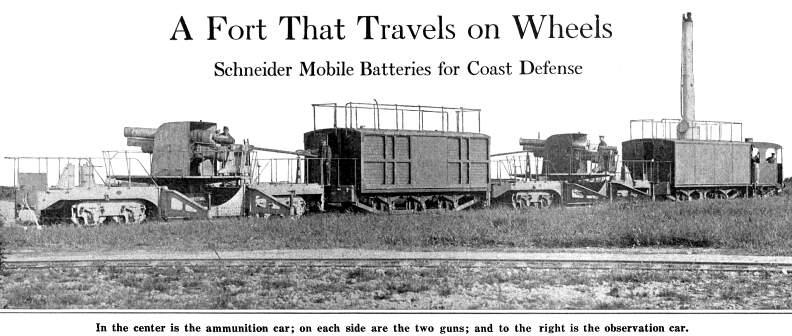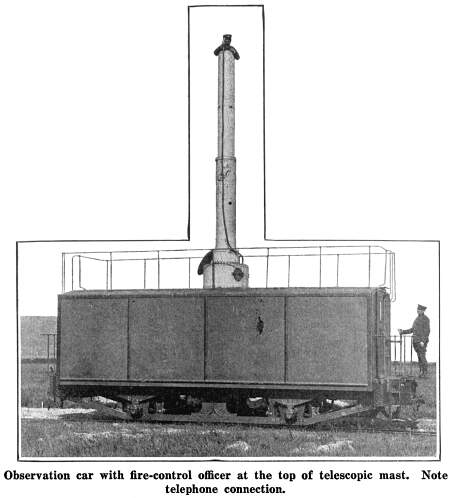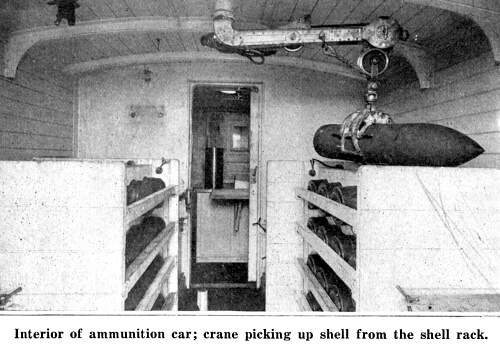|
THE COMPLETE SCHNEIDER COAST DEFENSE
TRAIN AS BATTERY
Scientific American—December 20,
1913

MOBILE batteries running on rails are well qualified to defend
along line of coast. Their use renders it possible to do away
with batteries which it would be otherwise necessary to provide
for the defense of areas included between the principal defensive
fortifications. By reason of their great mobility, these batteries
can be rapidly moved to points where it is necessary to reinforce
the defense, to enter immediately into action, or to withdraw,
either because they may be required elsewhere or to escape a well-directed
fire.
The temporary consolidation of a certain number of guns will
constitute a kind of movable fort, powerful and very economical.
The mobility of the batteries will be a protecting element far
more efficacious than the ramparts of permanent forts, upon which,
because of the advanced position of the outworks, the fire of
an enemy can be concentrated.
In addition to these various advantages, mobile batteries present
other merits, the principal ones of which are:
(a). Since the mobile batteries can take the place of fixed
coast batteries of the same offensive power, but of much more
costly construction, there is great economy in the preparation
of the defense. It is necessary merely to provide a railway.
(b). Complete secrecy of the plan of defense, since the placing
of a battery in position is not betrayed by preliminary work.
(c). A better utilization and economy of material, since the
guns will not be uselessly stationed in fixed positions in permanent
work.
(d). The material can be more easily kept in condition; for
in time of peace the batteries can be stored under cover and sheltered
from intemperate weather.
(e). It will be unnecessary to establish strategic roads for
conveying siege or field artillery material on wheels.
(f). The railway can be employed for other purposes than those
of the artillery. Thus in time of war it can be used for the rapid
transportation of infantry and the conveying of the necessary
ammunition to the defending batteries; and in time of peace for
the economical development of the coast by the transportation
of merchandise and passengers. The system herewith illustrated
has been developed by Schneider & Co., the well known makers
of armor and guns.
 The Battery—The mobile
battery consists of two massive steel cars, each carrying an 8-inch
rapid-fire gun, an ammunition car, and an observation car, the
whole constituting a train of four cars drawn by a locomotive
on an ordinary railway. The gun car is provided with two bogie
trucks and a sheet-steel platform, lower in the middle than at
the ends, in which lower part the 8-inch piece is carried on a
central swivel-mount. The gun and its carriage are similar to
other modern coast-defense weapons designed by Schneider. The
body of the car, the frame, and the brakes are all similar to
the corresponding parts on the ammunition car. The Battery—The mobile
battery consists of two massive steel cars, each carrying an 8-inch
rapid-fire gun, an ammunition car, and an observation car, the
whole constituting a train of four cars drawn by a locomotive
on an ordinary railway. The gun car is provided with two bogie
trucks and a sheet-steel platform, lower in the middle than at
the ends, in which lower part the 8-inch piece is carried on a
central swivel-mount. The gun and its carriage are similar to
other modern coast-defense weapons designed by Schneider. The
body of the car, the frame, and the brakes are all similar to
the corresponding parts on the ammunition car.
The observatory consists of two movable tubes, telescoping
one within the other, and of a short, fixed section of tube carried
on the car itself, and extending down to the frame. The fixed
tube section serves to guide the movable sections. The movable
tubes are telescoped into the fixed tubes when the train is traveling
to its destination. The smaller movable tube has an observation
platform at its upper end. The tower is operated by means of a
hand-operated hoisting apparatus within the car.

The gun has a caliber of 8 inches. Weight of projectile is
220 pounds; initial velocity, 1,400 foot-seconds; total length
of the gun barrel, 11 feet; maximum elevation, 60 degrees; maximum
depression minus five degrees; arc of fire, 360 degrees; weight
of the gun without breech blocks, 3,560 kilogrammes; weight of
the breech block is 140 kilogrammes; weight of the entire gun
mounting and car, 1,145 kilogrammes. The hydraulic recoil brake
is so constructed that the recoil can be readily taken up by the
truck and the rails of the track. The mechanism for returning
the gun to battery is sufficiently powerful to bring the piece
into position, even when the gun is trained at the maximum angle
of fire. The side members of the platform carry two articulated
swinging supports, the outer ends of which carry screw-adjusted
base plates, which are employed when the gun is swung around with
its longitudinal axis at right angles to the length of the car.
Ammunition is served to the gun by means of a small carriage,
which runs on a circular rail surrounding the piece.
 The Ammunition Car.—The
ammunition car is placed between the two gun, cars in the train,
so as to supply both pieces with projectiles. The projectiles
are stored in racks arranged within the car in a horizontal position.
The car is armored with plates one inch in thickness. The Ammunition Car.—The
ammunition car is placed between the two gun, cars in the train,
so as to supply both pieces with projectiles. The projectiles
are stored in racks arranged within the car in a horizontal position.
The car is armored with plates one inch in thickness.
The Observation Car.—The observation car
is usually coupled directly to the locomotive. From this position
the commanding officer can place his guns in the most favorable
positions, or to select a more advantageous point of observation.
The observatory at full extension provides an excellent platform
for spotting the fall of the shots.
Oddities Page | Contents
Page
|







